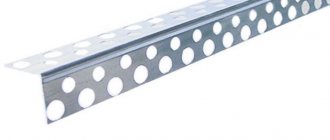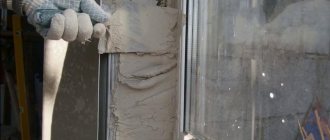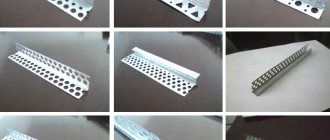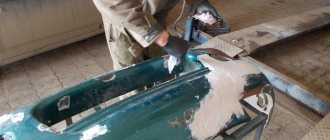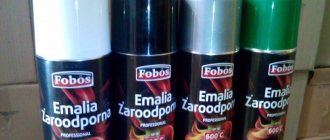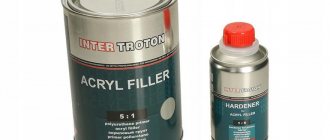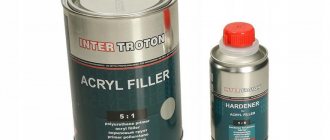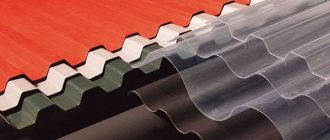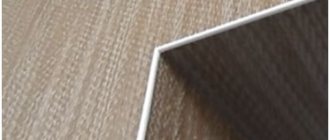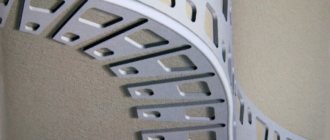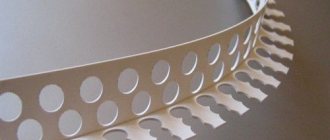The weak point of the window slope is the line where the frame meets the wall. Cracks often form on the seam; if the sealing is insufficient, it is blown through by the wind. Many problems arise during the plastering process: you need to carefully create a smooth plane of the slope and at the same time be careful not to stain the frame and glass unit with the solution. A special window adjacent profile with reinforcing mesh will make the craftsman’s work easier. Let's find out what this element is for, how to choose and use it correctly.
What is it for?
Plaster corner is an element for repair and finishing work.
Products are used to solve the following problems:
- leveling the surface before applying plaster, including corners in rooms;
- creating limiters for uniform distribution of putty and primer;
- cladding walls and partitions with ceramic tiles for plaster;
- strengthening external and internal corner spaces in the room;
- increasing the strength of the decorative finishing layer on arches, ledges and boxes;
- corners for plastering corners prevent the mixture from falling off;
- aesthetic design of transition zones near walls and ceilings;
- creating an even junction of wall panels, window and door slopes;
- preventing the formation of cracks and chips on surfaces;
- When applying plaster mixtures, corners are used as beacons.
Installation of products is carried out under the plaster mixture or on its surface, depending on the stage of repair and the design solution of the finishing. Without corners, the joints between sections may end up with unevenness and roughness.
The finishing element is universal in use; options have been developed for fixing on surfaces made of different materials.
Specifics and characteristics
The adjacent profile, as a rule, is equipped with a reliable fiberglass mesh glued to an additional shelf. The reinforcing mesh allows you to reliably fix the plaster liquid on slopes and practically eliminate the occurrence of cracks, visual unevenness and shedding of plaster, in particular located in critical areas of the profile abutment.
High-quality plastic is a good means for stable sealing and thorough sealing of all installation seams on window structures. The adjacent profile - unlike roll-tape sealants - is a more popular product for plastering slopes.
Characteristics:
- made from impact- and weather-resistant PVC, alkali-resistant;
- has a protective strip and a universal self-adhesive seal;
- resistant to UV rays;
- vapor barrier and waterproof;
- lightweight and easy to install, cut with scissors.
Types of corners for plastering work
Plaster corners differ in size (length, width), strength level, purpose, materials of manufacture, etc. The design of the perforated corner can be external or internal. The list of main types of profiles includes metal and plastic products.
Metal
Metal corners are made from different types of alloys (steel, aluminum, galvanized). Aluminum products are lightweight, reliable during installation, and durable. Aluminum corners are in demand in finishing work, because... The material is resistant to corrosion and does not increase the load on the wall panel.
Galvanized steel products are more durable, but are more susceptible to corrosion. The elements are used for interior decoration in rooms with low levels of air humidity. To prevent the formation of rust, experts recommend maintaining the integrity of the product during installation and cutting only with metal scissors.
Metal elements are used when working with finishing mixtures based on latex or acrylic. Metal corners are recommended for installation in rooms with high traffic, because... more durable than plastic products.
Plastic corner
The plastic corner for plaster is affordable, lightweight, and not susceptible to corrosion or mold. High-quality durable plastic is used in the production of elements. The products are suitable for use in rooms with high air humidity, because... are not damaged by moisture. Corners made of polymer materials can be used in the finishing of facade structures.
To work with the elements, use a construction knife or stationery scissors. The material is easy to cut and can be bent in the required direction without loss of quality characteristics. However, it is necessary to take into account the greater thickness of plastic products compared to metal ones.
Installation
- Mark the line along which the profile will adjoin the frame. It is most convenient to use a laser level, but if you don’t have one, a bubble level will do.
- The required section of the product is measured and cut. To do this, use metal scissors.
- For good adhesion, the frame is first cleaned of dust and other contaminants. Only under such conditions does the manufacturer guarantee the reliability of the resulting connection.
- The protective film is removed from the damper lamella, and the profile is glued to the frame along the marked strip. This is done as follows: after detaching a little of the film, the strip is aligned along the line and pressed against the box, after which the remaining protective layer is finally removed at an acute angle.
A variety of shapes of plaster corners made of plastic (PVC) and metal
According to configuration, profiles are available in the following subtypes:
- arched;
- straight;
- universal;
- with reinforced mesh for plaster;
- combined;
- perforated;
- paper, etc.
Right angles for slopes
Right angles are made of metal alloys and plastic. The product is shaped like a strip, bent at a right angle in the center. The profile edging is perforated for easy fixation on the base and improves adhesion characteristics. The thickness of the metal element reaches 0.5 mm, the polymer components - 1-1.5 mm.
The advantage of plastic corners is the absence of corrosion, therefore polymer elements are used for finishing facades and other external works. The thickness of such products with a right angle can reach more than 1-1.5 mm, so the element is not suitable for puttying the surface. However, for plastering work, a plastic corner is used.
Arched
Arched elements are divided into compact sections for easy bending when finishing arches and niches. Arched corners are used to level the side sections of arches, passages, and curved structures made of plasterboard ceilings on wall panels and ceilings. The product is used for external and internal corners.
Perforation in these elements is applied to one side or sidewall. The segmental design allows you to create even corners in complex architectural structures.
The advantages of arched profiles are as follows:
- elimination of uneven corner surfaces in arches;
- visual highlighting of an inconspicuous part of an arch or opening;
- the elements do not require additional processing and are fixed with an adhesive base;
- When done correctly, the products retain the aesthetics of the arched opening for a long time (up to 50 years);
- A wide range of colors of plastic corners for arches allows you to implement complex design solutions.
The work can use corners that are mounted under the plaster layer, and decorative elements for the final stage of finishing; they are fixed to the plaster. Elements for internal installation are often perforated, made of metal alloys or plastic. Decorative corners are represented by a wide range of materials; polyvinyl chloride, metal, cork, etc. are used in their production.
Universal
Universal products, made of plastic or metal alloys, have the shape of a tape, which can be used to edge non-standard areas of surfaces. The corners reach a width of 5 cm. The bending line of the element is located in the center, the corner is complemented by perforation. The products are made of high-quality plastic, ensuring durability during operation.
With reinforcing mesh
A corner with a metal mesh is used for wet plastering. The peculiarity of mesh products is the presence of perforated pads about 2-4 cm wide. Using these elements, you can level surfaces of different configurations.
The material is often used for facade finishing, including plastering over insulation. The mesh allows the mixture to pass through and is securely fixed to the wall panels. The elements are recommended for use when making a thick layer of plaster. Mesh inserts provide additional structural strength and allow you to create even angles on surfaces of complex configurations.
Combined type
Combined type corners are made from different materials. The list of popular products includes metal profiles with thick paper edging. The products are optimal for leveling the outer and inner corners of wall panels for putty. The elements are fixed with an adhesive solution.
Combined corners are created from aluminum or galvanized metal and fiberglass mesh. The products are durable and are used to create clear contours of corners on the outside of the wall. Using profiles, you can create smooth joints between surfaces made of different materials.
The mesh that complements the element can be plastic. These products, in addition to leveling corner areas, increase the strength of the base.
Perforated
Perforated corners for plaster are used to level outer corners or inner corner areas. The products are in demand, easy to install, and universal in use. Elements are produced for corners and can be plastic, galvanized, aluminum.
Products are produced in different widths. For accurate alignment, the material must be trimmed. To adjust metal elements, metal scissors are used. Galvanized profiles are characterized by increased rigidity and can be used as beacons during plastering. A perforated corner for putty is used to level the base and eliminate cracks.
Paper
Paper corners are made in the form of masking tape and sold in rolls. In the center of the strip of thick paper there is a marking for the fold. The canvas can be produced with fine perforation or on a self-adhesive basis. Paper corners are used to prepare corner sections of plasterboard walls and surfaces of other materials for applying the finishing layer of putty.
The products are also used to prepare plastered substrates for painting. Masking tape is often applied over the putty.
However, large deformations in corner areas cannot be corrected using paper corners. Therefore, you will need to use durable elements made of metal and plastic.
Advantages of starting profiles for PVC windows
These designs have a large number of advantages, thanks to which the installation of slopes will be simpler. Among them:
- the window opening can be quickly and easily leveled without the use of putty or plaster compounds only with the help of this design;
- starting profiles are easily attached to the wall using self-tapping screws or liquid nails;
- they have excellent decorative properties. By installing slope panels using starting profiles, you will get joints without sealing seams;
- ease of processing. Plastic structures can be easily cut with scissors, an electric jigsaw, a grinder, or even a simple stationery knife. PVC profiles also bend easily and take the required shape.
The manufacturability of the processes is achieved thanks to the special properties of polyvinyl chloride.
Beacon corner for plastering
Corners can be used as beacons when leveling the base for plastering. Using the elements, the required level for placing the mixture is created. After application, excess plaster solution is removed using the guide rail rule. As a result, the surface is leveled. Corners for beacons are made of plastic or galvanized metal. The cross-section is standard: L- or T-shaped. The height of the beacon can be 3-10 mm. The indicator is determined by the required thickness of the putty layer.
The advantages of beacons are as follows:
- simple installation;
- can be used in small areas;
- universal in use for floors, wall panels, ceilings;
- do not deform during operation;
- there is no need to remove them from the wall after finishing is completed.
How to properly install a plaster corner
Installation of corners for plastering slopes is carried out taking into account the following requirements for the base:
- products are placed on a solid area of the panel;
- Before installing the element, the area is treated with a primer;
- profiles are recorded by beacons;
- the solution is filled with a dense layer of the perforated surface;
- when placing an element vertically, a building level is used to level the area;
- when covering with a thin layer, the corners are fixed using dowels or self-tapping screws;
- First, the main surfaces are treated, corner surfaces are plastered at the final stage;
- The corners should not protrude above the plaster layer, therefore, if there are such parts on the surface, they are covered with leveling mixtures or sealant.
In addition to the general rules for installing corners, there are requirements for the order of fixing internal and external elements.
It is necessary to fasten the corner for plastering internal corners in compliance with the following sequence of actions:
- the plaster solution is applied by spraying, then the base is primed;
- the area is leveled using the rule of the direction of movement from the corner;
- Markings are made on the treated surface, then an angle is formed.
Configurations of reinforced corners (external, internal)
Painting corners can be used for both interior and exterior decoration. External corners are most often protected with aluminum profiles to protect the surface from abrasion, impacts and other damage.
Before you begin the work, you need to prepare the appropriate materials and tools:
- perforated aluminum corners;
- putty;
- sheet metal shears;
- spatula for applying the mixture.
Installation consists of 3 stages:
- Preparation of solution and profile. Using special scissors, adjust the size of the corners. After this, apply the finishing coat (according to the instructions on the package).
- Installation of aluminum corner. Distribute the solution on the surface, reinforce corners, and correct various irregularities.
- Grinding corners. After the finishing layer has dried, the surface is sanded with sandpaper or a special mesh.
Finishing of internal corners is carried out in a similar way.
The following tools are prepared for work:
- painting aluminum corners;
- putty;
- scissors for working with metal;
- putty knife.
Grouting corners and leveling wall surfaces
After the plaster mixture has hardened in the places where the corner pads are placed, plastering work is carried out in stages:
- using a trowel placed at an angle of 30-40°, the base is grouted;
- then a solution is applied near the profiles, which is smoothed using a rule to eliminate excess mixture;
- smooth the surface with a trowel;
- the bases are leveled, while the corners should not protrude outward;
- Polymerization is carried out on the dried wall panel and the final grouting begins;
- internal corners are rubbed using a grater with a sponge surface.
Finishing slopes with plaster
After installing new windows, the mounting foam is carefully cut off with a utility knife. The resulting cracks are sealed with plaster. Use a broom to remove construction debris from the surface of window openings. Before applying plaster, the slopes should be primed. The primer is a reliable link between the masonry and plaster, and ensures reliable adhesion of the two materials.
- At the initial stage, the working area is marked, leaving 1 cm of deviation from the perpendicular to the window frame;
- Beacons are placed along the surface of the slope using small particles of plaster material;
- Using a spatula, the plaster is applied and leveled along the slope. The beacons are gradually removed, and the vacant places are sealed with mortar;
- The layer of plaster dries for several days, after which all joints and edges of the window are sealed with putty.
To ensure natural expansion of the plastic and prevent the appearance of cracks in the plaster, the uncured mortar is cut with a spatula at the junction of the frame and the slope. The thickness of the groove must be at least 3 mm.
At the end of plastering work, roughness is cleaned with fine sandpaper. Plastered slopes are most often decorated with wallpaper or painted.
Typical errors in fastening and plastering
Novice finishing specialists may make the following mistakes:
- The perforated corner for plaster is installed without taking into account the technical characteristics. To prevent possible alteration of the surface, it is recommended to assess the technical condition of the panels and their junctions with the floor and ceilings.
- In the absence of priming, the material of the wall or ceiling will be visible through the plastered surface. Therefore, it is imperative to select a primer for the type of base.
- It is a mistake to treat surfaces in one room with long breaks. Plastering different areas is required sequentially within a limited time frame for high-quality and durable repairs.
- Plastic elements are fragile and, when installed in high-traffic areas, will not provide a durable plaster coating. Experts recommend installing metal corner elements in public buildings and hallways of residential buildings to prevent the plaster from falling off and the base from deforming.
- It is not recommended to cut galvanized metal corners into pieces using a grinder.
How to choose
Some tips for choosing a profile:
- The element must have a protective insert-cuff that covers the junction of the slope and the frame; in the absence of this junction, the end of the sealing lamella made of polyurethane foam will be visible around the perimeter, which easily absorbs moisture and dirt. It will get more and more dirty each time you wash the window, and it will look completely unsightly.
- It is recommended to pay attention to the color of the product. It is desirable that it be made of virgin PVC, which has a pure white tint. Upon completion of the work, the grayish PVC insert will stand out against the background of the white frame and will not look very aesthetically pleasing. In addition, the dirty gray profile made from recycled PVC is of poorer quality and breaks more easily.
- It is important to choose the correct height of the adjacent profile. There are models on sale with a height of 6, 8, 9 mm and more. For standard finishing with plaster and putty, you need to choose an element with a minimum height. If the slopes are insulated with penoplex, this value should be higher.
The marking of the models is as follows: 6 × 2400, where the first number indicates the height of the profile, and the second – its length. For example, profile 9 × 2400: profile height – 9 mm, length – 2.4 m.
The following video will tell you about the rules for choosing an adjacent profile:
Finishing external corners
When finishing the external corners of a room during the construction or major renovation of an apartment, the work is carried out using a beacon strip or corner metal profiles.
The first method involves placing a corner metal element to provide sufficient rigidity to the surfaces.
This method allows you to plaster panels combined at a corner and provide increased strength to the corner part of the room.
To implement another option, a lighthouse rail is used. In this case, first one part of the corner is plastered, then the next. The corner strip can be fixed to a thin layer of plaster applied in a continuous strip from ceiling to floor. Metal profiles can be cut to the required length if necessary.
